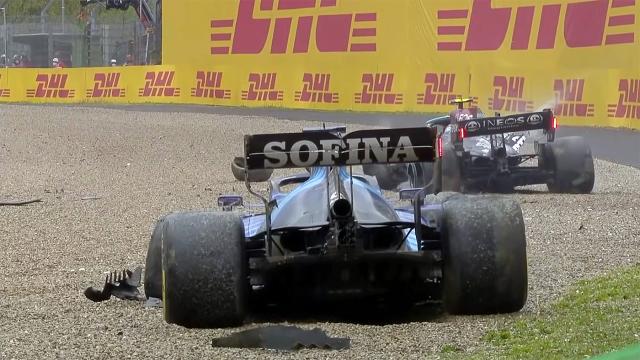Regardless of whom you blame for the high-speed collision between Valtteri Bottas and George Russell at last weekend’s Emilia Romagna Formula 1 race, we can all breathe a collective sigh that both drivers emerged safe. Bottas’ Mercedes suffered the biggest shunt, with Russell’s Williams jackknifing left after its rear wheels hit a wet patch on the fringe of the asphalt, sending it up and on top of the Mercedes’ sidepod. The halo safety device kept Bottas’ helmet clear of any impact, but the left-front tire of the Williams absolutely tore apart the side of the Finn’s car, as did the ensuing strikes with the circuit’s walls.
The official FIA Safety Instagram account published a brief but very enlightening video today illustrating how the construction of sidepods in Formula 1 cars has been updated to better withstand the force of a serious wreck, particularly at oblique angles. Imola proved a sobering show of the progress that’s been made.
Inside the sidepods are carbon fibre tubes that the FIA calls “impact absorption structures.” An earlier design for this component was vulnerable to shearing with a clean break, as footage from the FIA’s crash testing in the Instagram post shows. That’s no good — the goal is for those beams to degrade slowly, dissipating force all the while.
Current structures, like those on Bottas’ Mercedes, as well as all F1, F2 and F3 cars, are far better at achieving that progressive deformation. As the FIA says, the current design helps “decelerate the car in a controlled manner.”
“These side impact structures are the result of many years study, with the most recent step being to develop a geometry that works just as well in a direct impact as it does at an acute angle.
[…]
“In testing it absorbed the force of a 780kg (1719 pounds) sled running at a speed of 10 meters per second (35 km/h) — that is the equivalent of 15 tonnes trying to squash the chassis and another 11 tonnes trying to tear off the crash test tube.”
Modern F1 cars weigh a little less than the sled used in the FIA’s testing, at about 748 kg. It’s estimated that F1 cars travelling down Imola’s front straight into the Tamburello chicane hit about 330 km/h before braking.
When we think of safety in motorsports — particularly in open-wheel disciplines like F1 and IndyCar — we understandably spend a lot of time concentrating on head protection, perhaps in the event of a rollover collision or cars getting lifted atop one another. Similarly, drivers’ legs are an area of concern in the event of a forward crash.
But efforts are continually being made to fortify other areas of these chassis, like the sidepods. And given that what’s inside those sidepods is normally shielded from view, improvements that have been deployed typically go unrecognised. That is, until a big incident like this makes us thankful for their existence.
